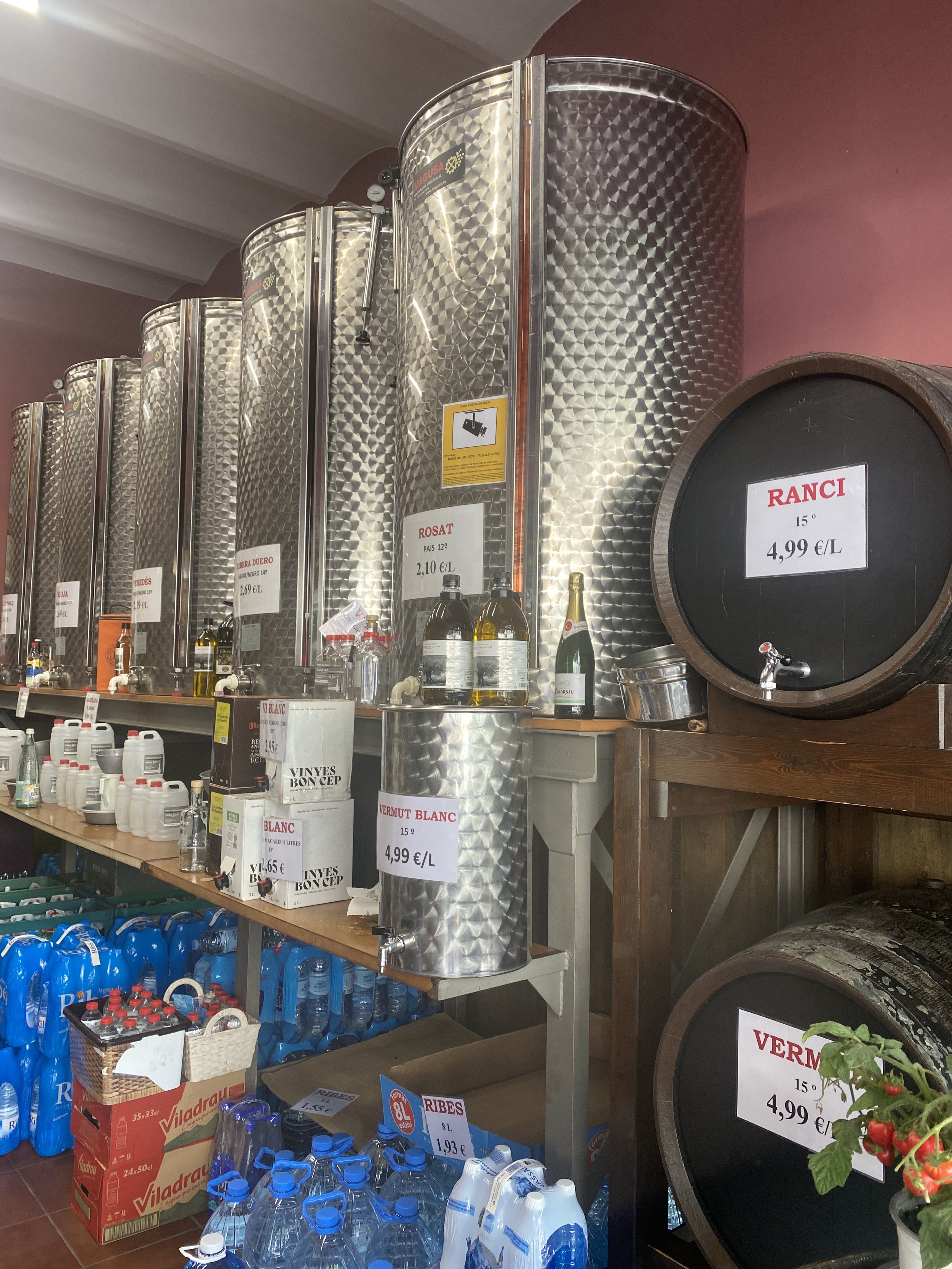rancio/rancí
Rancio is one of the most fascinating, unusual, and incomprehensible styles of wine. Given its extreme aromas which can be off-putting to some, it’s not common to find it any more. So I was pleasantly surprised to see quite a few producers in Priorat and Montsant in Catalunya continuing and even reviving the tradition.
My first encounter was at a superb restaurant in the small village of Porrera in Priorat. La Cooperativa is run by a husband and wife team and the food and presentation is of the highest standard. As is the wine list. For dessert or digestif there were several dozen wines from across Spain and Portugal. I ordered a rancio from a 1939 solera. The husband put the glass on the table alongside the bottle and shouted, “Rancid!”
For this is is the literal translation of rancio—or rancí in Catalan—giving an indication of its off aromas and why it’s not the most popular style. However, rancio also means tough or persistent: these are wines aged for many, many years which refuse to go away.
what is rancio?
First of all, it’s a fortified wine which stops it turning completely to vinegar—although there are definite vinegar notes to the aromas. It’s usually fermented to complete dryness, though there are sweet versions available (see Mas Martinet below). Like an oloroso sherry, it’s aged oxidatively which turns it amber-brown and gives nutty, leathery, dried fruit aromas. It may be aged not only oxidatively but also, like madeira or Rutherglen Muscat, be exposed to heat for baked and cooked fruit aromas. Uniquely, it’s sometimes put out in the sunlight and aged outdoors in glass jars. And it’s usually aged for a long time to develop those “rancid” aromas. Except no rancio is made in exactly the same way, which makes the wines fascinating but even more difficult to explain or understand.
where is rancio made?
Mas Martinet “Rancí Dolç”
Rancio is very much a Mediterranean—and particularly Catalan—style, in part because of the tradition for fortified wine and also because of the naturally warm conditions. The most famous French rancio come from Roussillon, which is Catalan France and which I wrote about when I visited two and a half years ago. The best known producer is Mas Amiel, who leave the wine in bonbonnes (glass demijohns) for two years before moving them to barrel.
Even though rancio is very much a Catalan tradition, I had always associated it with Roussillon in France, so I was pleasantly surprised to find so much rancio in Priorat in Catalunya. Until the late 1980s Priorat was a traditional, old-fashioned region. Although Priorat modernised in the 1990s, there is definitely an undercurrent to keep and revive Priorat’s traditions, even if this style of wine is unlikely to be much found outside the region.
Mas Martinet make an unusual rancio because it’s sweet at 80g/l, therefore labelled Rancí Dolç. The sweetness comes from drying the grapes (all Garnatxa) for between seven and 21 days to concentrate the sugars. It’s aged in demi-johns for a year after the harvest to expose the wine to oxygen, heat, and sunlight before being transferred to used Priorat barrels. The first release of this wine was in 2017, after 22 years’ ageing. The result is an astonishingly concentrated wine, black in colour, and full of dried fruit, game, animal, leather, and nutty aromas. Rich and complex: not a wine you could have more than a glass of—but a glass is like having a bottle of most other wines.
the small barrel — the 40% ABV distillate for the rancî
As mentioned in my Priorat post, Cims de Porrera used to be a co-operative and has expansive underground cellars ideal for ageing wine. On the rancio front though, everything is a bit upside down. Whites and reds are aged in demijohns in the cool, dark conditions, while the rancio is aged in barrels, again in cool, dark conditions. Here, the rancio style comes from extended ageing, with barrels dating back to 1998. Production is small, so only a little amount is taken out from time to time, and then topped up with younger wine. The grape variety is Carinyena, although I’m not sure what the grape variety is makes much difference given the rancio aromas dominate so much. However, the use of grape varieties such as Carinyena and the Garnacha family makes the wines richer and more aromatic than sherry for example. The spirit used for fortification is different from sherry or madeira, as it’s only 40%—in essence, a tasty brandy.
In neighbouring Montsant, Celler de Capçanes also make a rancio (and vermouth, as well as a rich, sweet red wine from Garnatxa and Carinyena). The ageing is more traditional, with around three dozen demijohns sitting on the rooftop directly in the sunshine (see header image), before heading to barrel where it is aged for at least five years before partial emptying.
The glass I had in the restaurant was by De Muller, who specialise in rancio and fortified wines. Based in Tarragona on the Mediterranean coast and founded in 1851, their production facilities have capacity for four million litres. This gives an idea of the scale and history of rancio/fortified production in Catalunya. The wine is called “Dom Juncosa,” named after a prior at the Scala Dei monastery in Priorat. The solera was established in 1939 to commemorate the end of the Civil War. For better or worse, within these wines is so much history. The wine is completely dry, and drinks like a rich, aged oloroso sherry—a perfect digestif.
That rancio is more important in Catalunya than I realised was confirmed when visiting Barcelona. A small wine shop I went into had a good selection of bottled wine, but you could also pour a litre or more of local wine from large stainless steel tanks. Not only that, there was an oak barrel of rancio to pour out of, for €5 a litre. Reason enough to move to Barcelona.






